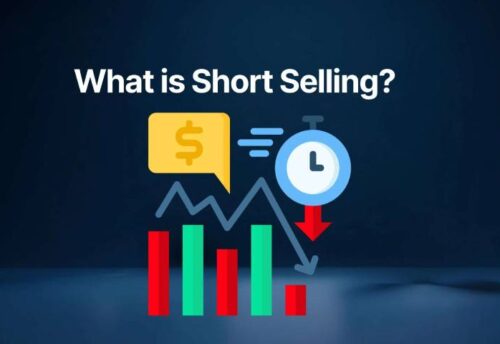
- 03/01/2025
- MyFinanceGyan
- 372 Views
- 4 Likes
- Finance, Investment
How to Diversify Your Portfolio in a Volatile Market
Market ups and downs are a part of every investor’s journey. When the stock market becomes volatile, many investors panic or make hasty decisions. But smart investors know how to use volatility as an opportunity — especially by diversifying their portfolio.
In this guide, we explain what market volatility means, why markets are uncertain today, and most importantly, how to diversify your investments to stay protected and grow your wealth.
What is Market Volatility?
Market volatility refers to the pace and frequency at which the stock market prices fluctuate. In simple terms, it shows how unstable or unpredictable the market is. Volatility can be caused by several factors such as economic news, inflation data, corporate earnings, interest rate changes, or global events.
In technical terms, volatility in stock market is measured using standard deviation, beta, or the Volatility Index (VIX). A highly volatile market can swing sharply in both directions, making it riskier — but also full of opportunities for prepared investors.
Volatile Meaning in Stock Market
The volatile meaning in stock market simply describes a condition where prices of shares and indices fluctuate sharply. A volatile market can move quickly without clear direction, making it harder to predict short-term performance. For long-term investors, volatility should be seen as part of the journey, not a reason to exit.
How to Calculate Market Volatility
You can calculate market volatility using the following methods:
- Standard Deviation: Measures how much a stock or fund deviates from its average return.
- Beta: Compares a stock’s volatility to that of the market. A beta over 1 means more volatile than the market.
- India VIX: The Volatility Index measures expected market fluctuations. A high VIX signals higher uncertainty.
Platforms like NSE, Moneycontrol, and TradingView offer tools to assess stock market volatility in real time.
How to Trade Volatile Markets
Trading in volatile markets can be risky if you’re not disciplined. Here are a few practical tips:
- Set strict stop-loss levels to protect capital
- Trade with smaller position sizes to reduce risk
- Avoid over-leveraging and limit margin usage
- Follow technical indicators like moving averages and RSI
- Avoid emotional trades — stay calm and stick to your plan
If you’re a beginner, it’s better to avoid aggressive trading in volatile phases and focus on long-term investing.
Why Diversification Matters in a Volatile Market
Diversification is the key to managing risk during uncertain times. In a volatile market, not all sectors or asset classes perform the same. Some may fall sharply, while others may stay stable or even rise.
- Diversifying your portfolio helps in the following ways:
- Reduces the impact of a fall in any one stock or sector
- Balances risk across asset types like equity, debt, gold, and real estate
- Helps manage emotions by reducing portfolio fluctuations
- Improves the chance of steady long-term returns
Common Mistakes to Avoid During Market Volatility
- Panic Selling: Selling low and locking in losses is a costly mistake.
- Overtrading: Too many trades in hope of quick profits backfire.
- Chasing Hype: Investing based on social media tips can be dangerous.
- Ignoring Asset Allocation: A lopsided portfolio is vulnerable to volatility.
Smart Ways to Diversify Your Portfolio
Here’s how you can safeguard your investments and even grow them in uncertain markets:
1. Invest Across Asset Classes: Don’t rely on just stocks. Mix equity, debt mutual funds, fixed income instruments, gold, and REITs for better stability.
2. Diversify Across Sectors: Avoid putting all your money in trending sectors like tech or pharma. Include others like banking, FMCG, or energy.
3. Add International Exposure: Invest in global mutual funds or ETFs to hedge against domestic market swings.
4. Use Mutual Funds or Index Funds: If you’re unsure which stocks to pick, mutual funds automatically offer diversified exposure.
5. Mix of Large Cap, Mid Cap, and Small Cap Funds: Large caps offer stability, mid caps provide balance, and small caps bring growth. A mix improves your overall risk-return profile.
6. Start SIPs to Tackle Volatility: A Systematic Investment Plan (SIP) allows you to invest at different price levels, which helps average out market volatility.
7. Keep an Emergency Fund: Ensure 3–6 months of expenses are kept liquid. This avoids dipping into investments during a market crash.
Why is the Market Volatile Today?
If you’re wondering why the market is volatile today, the reasons are often linked to global uncertainty and domestic pressures. As of July 2025, key causes include:
- Rising interest rates to combat inflation
- Geopolitical tensions impacting oil prices and trade
- FII (Foreign Institutional Investor) pullouts
- Mixed corporate earnings and sector-specific challenges
- Speculative trading by retail investors
This mix of economic, political, and investor-driven factors contributes to the current share market volatility.
Disclaimer:
This article is for educational purposes only and reflects the author’s personal views. It does not recommend specific products or services. Always consult a financial advisor before making investment decisions.



